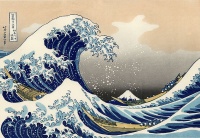Nature
From The Art and Popular Culture Encyclopedia
| Revision as of 13:02, 13 November 2012 Jahsonic (Talk | contribs) ← Previous diff |
Revision as of 13:02, 13 November 2012 Jahsonic (Talk | contribs) Next diff → |
||
| Line 7: | Line 7: | ||
| # The [[natural]] [[world]]; consisting of all things unaffected by or predating human [[technology]], production and design. e.g. the natural [[environment]], virgin ground, unmodified species, laws of nature. | # The [[natural]] [[world]]; consisting of all things unaffected by or predating human [[technology]], production and design. e.g. the natural [[environment]], virgin ground, unmodified species, laws of nature. | ||
| - | # The [[innate]] [[characteristics]] of a thing. What something will tend by its own constitution, to be or do. Distinct from what might be expected or intended. | + | # The [[innate]] [[characteristics]] of a thing. What something will tend by its own constitution, to be or do. Distinct from what might be expected or intended. See for example [[human nature]] |
| # The [[summary]] of [[everything]] that has to do with [[biological]], [[chemical]] and [[physical]] [[state]]s and [[event]]s in the physical [[universe]]. | # The [[summary]] of [[everything]] that has to do with [[biological]], [[chemical]] and [[physical]] [[state]]s and [[event]]s in the physical [[universe]]. | ||
Revision as of 13:02, 13 November 2012

The 49th plate from Ernst Haeckel's Kunstformen der Natur of 1904, showing various sea anemones classified as Actiniae.
|
Related e |
|
Featured: |
- The natural world; consisting of all things unaffected by or predating human technology, production and design. e.g. the natural environment, virgin ground, unmodified species, laws of nature.
- The innate characteristics of a thing. What something will tend by its own constitution, to be or do. Distinct from what might be expected or intended. See for example human nature
- The summary of everything that has to do with biological, chemical and physical states and events in the physical universe.
Nature, in the broadest sense, is equivalent to the natural world, physical universe, material world or material universe. "Nature" refers to the phenomena of the physical world, and also to life in general. The term generally does not include manufactured objects and human interaction unless qualified in ways such as, e.g., "human nature" or "the whole of nature". Nature is also generally distinguished from the supernatural and the unnatural.
Contents |
Aesthetics and beauty
Beauty in nature has historically been a prevalent theme in art and books, filling large sections of libraries and bookstores. That nature has been depicted and celebrated by so much art, photography, poetry and other literature shows the strength with which many people associate nature and beauty. Reasons why this association exists, and what the association consists of, is studied by the branch of philosophy called aesthetics. Beyond certain basic characteristics that many philosophers agree about to explain what is seen as beautiful, the opinions are virtually endless. Nature and wildness have been important subjects in various epochs of world history. An early tradition of landscape art began in China during the Tang Dynasty (618-907). The tradition of representing nature as it is became one of the aims of Chinese painting and was a significant influence in Asian art.
Wilderness portrayals in art became more prevalent in the 1800s, especially in the works of the Romantic movement. British artists John Constable and JMW Turner turned their attention to capturing the beauty of the natural world in their paintings. Before that, paintings had been primarily of religious scenes or of human beings. William Wordsworth's poetry described the wonder of the natural world, which had formerly been viewed as a threatening place. Increasingly the valuing of nature became an aspect of Western culture. This artistic movement also coincided with the Transcendentalist movement in the Western world. A common classical idea of beautiful art involves the word mimesis, the imitation of nature. Also in the realm of ideas about beauty in nature is that the perfect is implied through symmetry, equal division, and other perfect mathematical forms and notions.
Art in nature and nature in art
Antonym
See also
Science:
Philosophy:
- Mother Nature
- Nature (philosophy)
- Naturalism (philosophy): any of several philosophical stances, typically those descended from Materialism and Pragmatism that do not distinguish the supernatural from nature. This includes the methodological naturalism of natural science, which makes the methodological assumption that observable events in nature are explained only by natural causes, without assuming either the existence or non-existence of the supernatural.
- Balance of nature (biological fallacy): A discredited concept of natural equilibrium in predator:prey dynamics.
Media:
- Natural History, by Pliny the Elder
- Nature, by Ralph Waldo Emerson
- Nature, a prominent scientific journal
- National Wildlife Magazine, publication of the National Wildlife Federation
- Nature (TV series)
- The Nature Conservancy
- Nature Detectives




